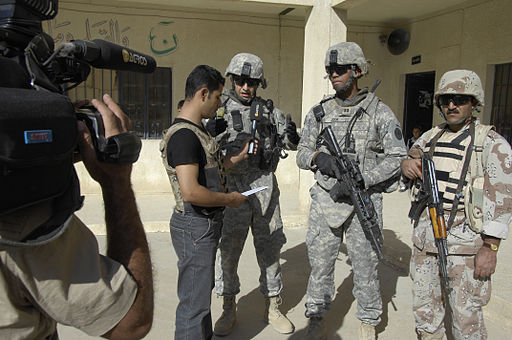While researching for her biography All In: The Education of General David Petraeus, Paula Broadwell spent months in Afghanistan with General Petraeus, then-commander of the International Security Assistance Force, to fully understand America’s most prominent general of the last decade. The now-infamous affair that ensued between Broadwell and her subject during that time shed new light on the complicated relationship between the media and the military. The scandal demonstrated how contemporary media coverage of the military may lead to the disclosure of sensitive material and also how it causes reporting bias. As the nation winds down over a decade of war, it is time to analyze the complex relationship between journalists and soldiers.
The relationship between the press and the armed forces has not always been as close as today’s. After journalists relayed overtly negative stories to the American public during the Vietnam War, the military increasingly distanced itself from the media. Even as late as the Persian Gulf War, journalists were strictly managed and generally kept separate from American servicemen and women. This policy changed during Operation Iraqi Freedom, when the U.S. Department of Defense allowed 600 journalists to embed with the troops.
The intimacy provided certain advantages. On the one hand, the military was reported in a more favorable light, since journalists wrote about men and women they knew and interacted with on a daily basis. On the other, reporters received detailed knowledge and information about their subjects, and the public became better informed. Embedded journalists received an added benefit: protection. Of the 150 media workers killed on the job in Iraq from 2003 to 2011, only 26 were not Iraqis. Essentially all foreign journalists employ security — for those embedded, this safety is free and guaranteed.
The close relationship, however, has several disadvantages. First, the media may be granted too much access to the military, depending on your views regarding freedom of information. Nonetheless, it is true, despite our opinion on the legitimacy of this freedom and whether it pertains to all state information (as Julian Assange and his followers would believe), the media may reveal information that is clearly not in the interest of the military. The 2010 Rolling Stone interview with General Stanley McChrystal, for instance, revealed serious personal divides within the defense organization. As a result of his public comments, General McChrystal was relieved of his command, and soon after the incident then-Defense Secretary Robert Gates issued a memo to officials urging caution in interactions with the media.
Second, when journalists act closely with troops, they tend to exhibit bias in favor of the military. (A notable counterexample to this trend is the behavior of the media during the Vietnam War, when journalists were biased against the American military.) From the two World Wars to Iraq, the closer reporters are to soldiers, the more agreeable the relationship. While the journalist-soldier embrace may be beneficial to the armed forces, it deprives the public of a truly accurate picture of the situation on the ground.
It is dubious to assert any piece written in a war zone, however, would be impartial, yet the information embedded journalists glean is unsurpassed. Biased reporting is not necessarily an evil. Neutrality is certainly valuable, but writers and reporters should also be able to convey their perspectives. Doing so provides a more accurate picture of their experiences. If we accept the premise of biased reporting though, it is important we recognize it when we read it — something the public may not do. The problem is bias is often reported and interpreted as fact, so we believe we gain a neutral standpoint on a topic when the opposite is true.
Attempting to destroy media bias is neither realistic nor appropriate. Instead of trying to change how journalists tell their stories, we should recognize that although there are certainly many pieces with a pro-military bent, there are also reports with opposing viewpoints. We should train ourselves to more accurately identify this partiality, and in doing so pro-military media bias would become simply another perspective from which we read the news.
